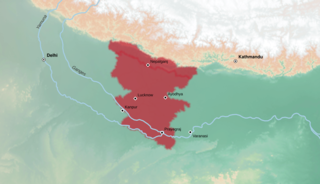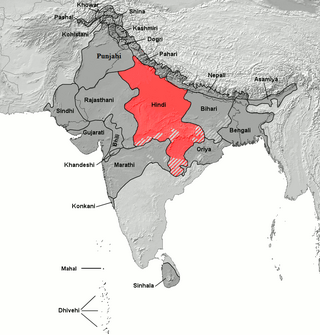Related Research Articles

Prakrit is a group of vernacular Middle Indo-Aryan languages that were used in the Indian subcontinent from around the 3rd century BCE to the 8th century CE. The term Prakrit is usually applied to the middle period of Middle Indo-Aryan languages, excluding earlier inscriptions and Pali.
Pali is a Middle Indo-Aryan liturgical language on the Indian subcontinent. It is widely studied because it is the language of the Buddhist Pāli Canon or Tipiṭaka as well as the sacred language of Theravāda Buddhism.

The Indo-Aryan languages are a branch of the Indo-Iranian languages in the Indo-European language family. As of the early 21st century, they have more than 800 million speakers, primarily concentrated in India, Pakistan, Sri Lanka, Bangladesh, Nepal and Maldives. Moreover, apart from the Indian subcontinent, large immigrant and expatriate Indo-Aryan–speaking communities live in Northwestern Europe, Western Asia, North America, the Caribbean, Southeast Africa, Polynesia and Australia, along with several million speakers of Romani languages primarily concentrated in Southeastern Europe. There are over 200 known Indo-Aryan languages.

Magahi, also known as Magadhi, is a Indo-Aryan language spoken in Bihar, Jharkhand and West Bengal states of eastern India, and in the Terai of Nepal. Magadhi Prakrit was the ancestor of Magahi, from which the latter's name derives.

Awadhi, also known as Audhi (औधी), is an Indo-Aryan language spoken in the Awadh region of Uttar Pradesh in northern India. The name Awadh is connected to Ayodhya, the ancient city, which is regarded as the homeland of the Hindu god Rama. It was, along with Braj, used widely as a literary vehicle before being displaced by Hindi in the 19th century.
Hindustani is one of the predominant languages of South Asia, with federal status in the republics of India and Pakistan in its standardized forms of Hindi and Urdu respectively. It is widely spoken and understood as a second language in Nepal, Bangladesh, and the Persian Gulf and as such is considered a lingua franca in the northern Indian subcontinent. It is also one of the most widely spoken languages in the world by total number of speakers. It developed in north India, principally during the Mughal Empire, when the Persian language exerted a strong influence on the Western Hindi languages of central India; this contact between the Hindu and Muslim cultures resulted in the core Indo-Aryan vocabulary of the Indian dialect of Hindi spoken in Delhi, whose earliest form is known as Old Hindi, being enriched with Persian loanwords. Rekhta, or "mixed" speech, which came to be known as Hindustani, Hindi, Hindavi, and Urdu, also locally known as Lashkari or Lashkari Zaban in long form, was thus created. This form was elevated to the status of a literary language, and after the partition of colonial India and independence this collection of dialects became the basis for modern standard Hindi and Urdu. Although these official languages are distinct registers with regards to their formal aspects, such as modern technical vocabulary, they continue to be all but indistinguishable in their vernacular form. From the colonial era onwards, Hindustani has also taken in many words from English, with an urban English-influenced variety emerging known as Hinglish.

The Hindi Belt, also known as the Hindi Heartland, is a linguistic region encompassing parts of northern, central, eastern, and western India where various Northern, Central, Eastern and Western Indo-Aryan languages are spoken, with Hindi as the lingua franca.
Dramatic Prakrits were those standard forms of Prakrit dialects that were used in dramas and other literature in medieval India. They may have once been spoken languages or were based on spoken languages, but continued to be used as literary languages long after they ceased to be spoken. Dramatic Prakrits are important for the study of the development of Indo-Aryan languages, because their usage in plays and literature is always accompanied by a translation in Sanskrit.
Shauraseni Prakrit was a Middle Indo-Aryan language and a Dramatic Prakrit. Shauraseni was the chief language used in drama in medieval northern India. Most of the material in this language originates from the 3rd to 10th centuries, and represented a regional language variety with minor modifications to the same linguistic substratum as other Dramatic Prakrit varieties. It may be based on the spoken vernacular around the 2nd century BC in the ancient state of Surasena.
Gāthā is a Sanskrit term for 'song' or 'verse', especially referring to any poetic metre which is used in legends, and is not part of the Vedas but peculiar to either Epic Sanskrit or to Prakrit. The word is originally derived from the Sanskrit/Prakrit root gai, which means 'to speak, sing, recite or extol', cognate to the Avestan term gatha.

Bishnupriya Manipuri, also known as Bishnupriya Meitei or simply as Bishnupriya, is an Indo-Aryan lect belonging to the Bengali–Assamese linguistic sub-branch. It is a creole of Bengali language and Meitei language and it still retains its pre-Bengali features. It is spoken in parts of the Indian states of Assam, Tripura and Manipur as well as in the Sylhet Division of Bangladesh. It uses the Bengali-Assamese script as its writing system. Bishnupriya Manipuri, being a member of the Eastern Indo-Aryan languages, was evolved from Magadhi Prakrit. So, its origin is associated with Magadha realm. The Government of Tripura categorised Bishnnupriya Manipuri under the "Tribal Language Cell" of the State Council of Educational Research and Training. Its speakers are also given the "Other Backward Classes" status by the Assam Government and notably, there is no legal status of the Bishnupriyas in Manipur. In the 2020s, the Bishnupriya speaking people started demanding that the Assam Government should give them the status of "indigenous people" of Assam and treat the same like other indigenous communities of the state.
The Middle Indo-Aryan languages are a historical group of languages of the Indo-Aryan family. They are the descendants of Old Indo-Aryan and the predecessors of the modern Indo-Aryan languages, such as Hindustani (Hindi-Urdu), Bengali and Punjabi.
Magadhi Prakrit (Māgadhī) is of one of the three Dramatic Prakrits, the written languages of Ancient India following the decline of Pali and Sanskrit. It was a vernacular Middle Indo-Aryan language, replacing earlier Vedic Sanskrit.

Caribbean Hindustani is an Indo-Aryan language spoken by Indo-Caribbeans and the Indo-Caribbean diaspora. It is a koiné language mainly based on the Bhojpuri and Awadhi dialects. These Hindustani dialects were the most spoken dialects by the Indians who came as immigrants to the Caribbean from India as indentured laborers. It is closely related to Fiji Hindi and the Bhojpuri-Hindustani spoken in Mauritius and South Africa.

The Western Hindi languages are a branch of the Indo-Aryan language family spoken chiefly in Haryana, western Uttar Pradesh and Bundelkhand region of Madhya Pradesh, in Northern and Central India. The Western Hindi languages evolved from Sauraseni Prakrit. The most-spoken language in the Western Hindi language family is Standard Hindi, one of the official languages of the Indian Union and one of the 22 Scheduled Languages of India.

The Eastern Indo-Aryan languages, also known as Māgadhan languages, are spoken throughout the eastern region of the subcontinent, which includes Bihar, Uttar Pradesh, Jharkhand, Bengal region, Tripura, Assam, and Odisha; alongside other regions surrounding the northeastern Himalayan corridor. Bengali is official language of Bangladesh and the state of West Bengal, Tripura and the Barak valley of Assam while Assamese and Odia are the official languages of Assam and Odisha, respectively. The Eastern Indo-Aryan languages descend from Abahattha, which descends from Magadhan Apabhraṃśa and ultimately from Magadhi Prakrit.

The Central Indo-Aryan languages or Hindi languages are a group of Indo-Aryan languages spoken across Northern and Central India. These language varieties form the central part of the Indo-Aryan language family, itself a part of the Indo-European language family. They historically form a dialect continuum that descends from the Middle Prakrits. Located in the Hindi Belt, the Central Zone includes the Dehlavi (Delhi) dialect of the Hindustani language, the lingua franca of Northern India that is the basis of the Modern Standard Hindi and Modern Standard Urdu literary standards. In regards to the Indo-Aryan language family, the coherence of this language group depends on the classification being used; here only Eastern and Western Hindi languages will be considered.

The Eastern Hindi languages are a branch of the Indo-Aryan language family spoken chiefly in Awadh region of Uttar Pradesh, Baghelkhand region of Madhya Pradesh, and Chhattisgarh, in Northern and Central India. Eastern Hindi languages evolved from Ardhamagadhi Prakrit.

Ashokan Prakrit is the Middle Indo-Aryan dialect continuum used in the Edicts of Ashoka, attributed to Emperor Ashoka of the Mauryan Empire who reigned 268 BCE to 232 BCE. The Edicts are inscriptions on monumental pillars and rocks throughout the Indian subcontinent that cover Ashoka's conversion to Buddhism and espouse Buddhist principles.
The Inner–Outer hypothesis of the subclassification of the Indo-Aryan language family argues for a division of the family into two groups, an Inner core and an Outer periphery, evidenced by shared traits of the languages falling into one of the two groups. Proponents of the theory generally believe the distinction to be the result of gradual migrations of Indo-Aryan speakers into the Indian subcontinent, with the inner languages representing a second wave of migration speaking a different dialect of Old Indo-Aryan, overtaking the first-wave speakers in the center and relegating them to the outer region.
References
- ↑ Saksena, Baburam (1971). Evolution of Awadhi (a Branch of Hindi). Motilal Banarsidass Publishers. p. 7. ISBN 9788120808553.
- ↑ Harrison, Selig S. (2015). India: The Most Dangerous Decades. Princeton University Press. p. 26. ISBN 9781400877805.
- ↑ "Prakrit".
- ↑ Cardona, George; Jain, Dhanesh, eds. (2003), "The historical context and development of Indo-Aryan", The Indo-Aryan Languages, Routledge language family series, London: Routledge, pp. 46–66, ISBN 0-7007-1130-9
- ↑ Zograph, G.A. (8 March 2023). Languages of South Asia: A guide. Taylor & Francis. ISBN 9781000831658.
Numerically, the content of the Central Group of the Indo-Aryan languages has been very variously assessed by different researchers: Chatterji sees in it one language while Grierson enumerated six. Strictly speaking, the core of this group is represented not by languages at all, but by a number of closely related dialects-Braj, Kanauji and Bundell, which together with Khari Boli and Hariani, can be lumped under the common title 'Western Hindi'. The last-mentioned two dialects which occupy the north-western corner of the area covered by Hindi, display a number of common features with Panjabi, which in its turn can be seen as a transitional link with the most typical representative of the North Western group – Lahnda.
Closely connected with the dialects of the 'Western Hindi' group are Awadhi, Bagheli and Chattisgarhi, which come under the heading of 'Eastern Hindi". Linguistically, these can be regarded as a transitional stage between the Central and the Eastern groups of languages. The 'intermediate' character of this group of dialects seems to have taken shape as far back as the Old Indo-Aryan period. The Middle Indo-Aryan forerunner of the contemporary Eastern Hindi dialects was the Ardhamagadhi Prakrit, which was a transitional form between Sauraseni and Magadhi; the present-day Central dialects go back to Sauraseni, while the languages of the Eastern group derive from Magadhi - ↑ Constance Jones; James D. Ryan (2006). Encyclopedia of Hinduism. Infobase Publishing. p. 42. ISBN 978-0-8160-7564-5.